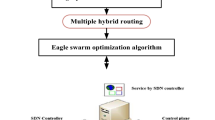Abstract
The distributed nature and dynamic topology of hierarchical low power wireless networks have made them an interesting platform for ubiquitous applications and smart environments. Wireless Sensor and Actuator Networks are a well known example in this area where the nodes collaborate to disseminate data over multi-hop routing trees. Emerging applications like smart grids and internet of things, demand more traffic volumes with QoS requirements, such as delay and reliability. The traditional shortest path routing fails to meet these demands because of producing more congestion, delay, packet loss, and energy consumption along the limited optimal paths. Multipath routing is a promising way to meet both the QoS constraints and lifetime concerns. In this paper we propose a proactive multipath load balancing approach which tries to achieve maximum lifetime by equalizing the traffic rate between the nodes of equal distance from the local sink. The load balancing and QoS provision is achieved through a network flow optimization problem, which is locally solved by a novel Heuristic Optimal Load Distributor. The load distribution is performed over a routing graph produced by a Multi-class Multipath Routing Protocol for Low power and lossy networks (\(\hbox {M}^2\hbox {RPL}\)). The simulation results show the efficiency of the proposed framework, that leads to 30 % increase in lifetime and 10 % decrease in average delay compared to some well known algorithms in the area.











Similar content being viewed by others
References
Kushulnagar, N., Montenegro, G., & Shumacher, C. (2007). Ipv6 over low-power wireless personal area networks (6lowpans): Overview, assumptions, problem statement, and goals (2007). RFC4919.
Xiaonan, W., & Shan, Z. (2013). A hierarchical scheme on achieving all-ip communication between wsn and ipv6 networks. International Journal of Electronics and Communications, 67, 414.
Winter, T., & Thubert, P. (2012). Rpl: Ipv6 routing protocol for low-power and lossy networks (2012). RFC6550.
Hassanein, H., & Luo, J. (2006). In: 2nd IEEE workshop on dependability and security in sensor networks and systems (pp. 54–64). Los Alamitos, CA.
Huang, X., & Fang, Y. (2008). Multiconstrained qos multipath routing in wireless sensor networks. Wireless Networks, 14, 465. doi:10.1007/s11276-006-0731-9.
Li, S., Ma, X., Wang, X., & Tan, M. (2011). Energy-efficient multipath routing in wireless sensor network considering wireless interference. Journal of Control Theory and Applications, 9(1), 127. doi:10.1007/s11768-011-0263-4.
Teo, J., Ha, Y., & Tham, C. (2008). Interference-minimized multipath routing with congestion control in wireless sensor network for high-rate streaming. IEEE Transactions on Mobile Computing, 7(9), 1124. doi:10.1109/TMC.2008.24.
Sha, K., Gehlot, J., & Greve, R. (2013). Multipath routing techniques in wireless sensor networks: A survey. Wireless Personal Communications, 70(2), 807. doi:10.1007/s11277-012-0723-2.
Eghbali, A. N., & Dehghan, M. (2007). In: Proceedings of the 3rd international conference on Mobile ad-hoc and sensor networks (pp. 44–55) Berlin: Springer, 2007, MSN’07. http://dl.acm.org/citation.cfm?id=1781974.1781982.
Tao, M., Lu, D., & Yang, J. (2012). An adaptive energy-aware multi-path routing protocol with load balance forwireless sensor networks. Wireless Personal Communications, 63, 823.
Karkazis, P., Trakadas, P., Leligou, H., Sarakis, L., Papaefstathiou, I., & Zahariadis, T. (2012). Evaluating routing metric composition approaches for qos differentiation in low power and lossy networks. Wireless Networks, (pp. 1–16). doi:10.1007/s11276-012-0532-2.
Uthra, R., & Raja, S. (2012). Qos routing in wireless sensor networksa survey. ACM Computing Surveys, 45(1), doi:10.1145/2379776.2379785.
Medjiah, S., Ahmed, T., & Asgari, A. (2012). Streaming multimedia over wmsns: An online multipath routing protocol. International Journal of Sensor Networks, 11(1), 10.
Felemban, E., Lee, C., & Ekici, E. (2006). Mmspeed: Multipath multi-speed protocol for qos guarantee of reliability and timeliness in wireless sensor networks. IEEE Transactions on Mobile Computing, 5(6), 738.
Kim, S. (2012). An ant-based multipath routing algorithm for qos aware mobile ad-hoc networks. Wireless Personal Communications, 66, 739. doi:10.1007/s11277-011-0361-0.
Krishna, P., Saritha, V., Vedha, G., Bhiwal, A., & Chawla, A. (2012). Quality-of-service-enabled ant colony-based multipath routing for mobile ad hoc networks. IET Communications, 6(1), 76. doi:10.1049/iet-com.2010.0763.
Carballido Villaverde, B., Rea, S., & Pesch, D. (2012). Inrout: A qos aware route selection algorithm for industrial wireless sensor networks. Ad Hoc Networks, 10(3), 458. doi:10.1016/j.adhoc.2011.07.015.
Ronasi, K., Mohsenian-Rad, A., Gopalakrishnan, S., Wong, V., & Schober, R. (2011). Delaythroughput enhancement in wireless networks with multipath routing and channel coding. IEEE Transaction on Vehicular Technology, 60(30), 1116. doi:10.1109/TVT.2010.2103097.
Tulasiraman, P., Chen, J., & Shen, X. (2011). Multipath routing and max-min fair qos provisioning under interference constraints in wireless multihop networks. IEEE Transactions on Parallel and Distributed Systems, 22(5), 716. doi:10.1109/TPDS.2010.145.
Bagula, A. (2010). Modelling and implementation of qos inwireless sensor networks: Amulticonstrained traffic engineeringmodel. EURASIP Journal onWireless Communications and Networking, 2010, doi:10.1155/2010/468737.
Ben-Othman, J., & Yahya, B. (2010). Energy efficient and qos based routing protocol for wireless sensor networks, Journal of Parallel and Distributed Computing, 70(8), 849. doi:10.1016/j.jpdc.2010.02.010. http://www.sciencedirect.com/science/article/pii/S0743731510000341.
Thubert, P. (2012). Objective function zero for the routing protocol for low-power and lossy networks (rpl) (2012). RFC6552.
Bertsekas, D., & Tsitsiklis, J. (1997). Parallel and distributed computation: Numerical methods (Athena Scientific, 1997), chap. 5: Network Flow Problems, (p. 417).
Kwon, O., Oh, H., Lee, Z., Lee, G., Park, Y., & Song, H. (2013). Entire network load-aware cooperative routing algorithm for video streaming over mobile ad hoc networks. Wireless Communications and Mobile Computing, 13, 1135. doi:10.1002/wcm.1169.
Author information
Authors and Affiliations
Corresponding author
Rights and permissions
About this article
Cite this article
Moghadam, M.N., Taheri, H. & Karrari, M. Multi-class Multipath Routing Protocol for Low Power Wireless Networks with Heuristic Optimal Load Distribution. Wireless Pers Commun 82, 861–881 (2015). https://doi.org/10.1007/s11277-014-2257-2
Published:
Issue Date:
DOI: https://doi.org/10.1007/s11277-014-2257-2




